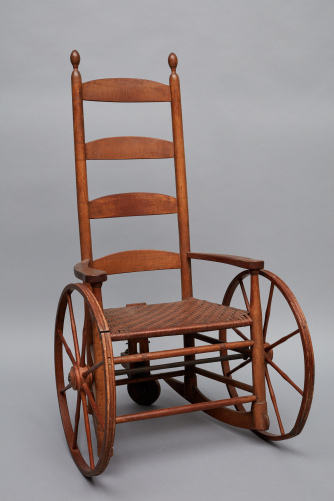
Wheelchair, Mount Lebanon, NY, Ca. 1830, Shaker Museum | Mount Lebanon: 1957.8417.1, John Mulligan, photographer
The Shakers made a sincere effort to accommodate the needs of all members of their community, including young, old, and disabled people. This wheelchair is a fine example of endeavors to ensure members with special needs could participate in community life. The chair, while not a suitable vehicle for a Shaker to transport himself or herself outdoors […]

Wheelchair, Mount Lebanon, NY, ca. 1830, Shaker Museum | Mount Lebanon: 1957.8417.1, John Mulligan, photographer.
The Shakers made a sincere effort to accommodate the needs of all members of their community, including young, old, and disabled people. This wheelchair is a fine example of endeavors to ensure members with special needs could participate in community life. The chair, while not a suitable vehicle for a Shaker to transport himself or herself outdoors on flagstone walks, was certainly useful in moving around within the dwelling house. Several items in the Museum’s collection speak to the care of those with specific physical needs: an orthopedic shoe, canes, and a walker.
This modified rocking chair was made at Watervliet or possibly Mount Lebanon. While it seems odd at first glance that the chair would have both rockers and wheels, most all arm chairs used in Shaker communities would have had rockers; side chairs with arms were unusual during the first half of the nineteenth century, well before the first patent was taken out on a self-propelled wheelchair in 1869. The date for the conversion of the rocker into a wheelchair is not known, but it was probably done in the first half of the nineteenth century. All of the metal parts for the chair are hand-forged and no commercial fittings were used. The Shakers at Mount Lebanon had among them both spinning wheel makers and wagon makers so fabricating the wheels for the chair would not have been particularly difficult. The wheels on the chair had “tires” made of leather that fit into half-round grooves in the outside of their rims. The chair, evidenced from two notches in the middle front stretcher (rung), was once fitted with some type of foot rest attached to that stretcher.
The wheelchair was acquired in 1957 at Hancock Shaker Village from Eldress Emma B. King, but was, according to the Museum’s accession records, one of the thousands of items brought to Hancock from Mount Lebanon when the latter community closed.

Wheelchair, Mount Lebanon, NY, Ca. 1830, Shaker Museum | Mount Lebanon: 1957.8417.1, John Mulligan, photographer

Wheelchair, Mount Lebanon, NY, Ca. 1830, Shaker Museum | Mount Lebanon: 1957.8417.1, John Mulligan, photographer
Though we don’t know who this wheelchair was made for, another mystery is why the middle front stretcher, the one from which the wheelchair’s footrest was hung, is so close to the front seat stretcher. This is a unique stretcher placement for a Shaker chair. There is no evidence that this stretcher was added later and no evidence that there had been middle stretcher where one would usually be found. If the stretcher placement indicates that the chair was built originally as a wheelchair, then why the vestigial rockers? Share your guesses in the comments!